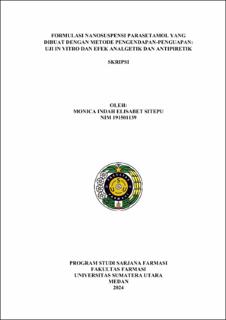| dc.description.abstract | Background: Paracetamol use to relieve pain and fever, generally formulated in
suspension form. The disadvantage of suspension caused caking, so
nanosuspension was developed, using the evaporative-precipitation method with
polymer variation.
Objective: To formulate paracetamol nanosuspension using the evaporativeprecipitation
method with polymer variation, characterization, and comparison of
analgesic and antipyretic activity with suspension.
Method: Paracetamol nanosuspension was prepared by the evaporativeprecipitation
method, dissolving 400mg of paracetamol into 2 mL of ethanol. The
solution of paracetamol is mixed into water-phase, which consisted of Tween 80
solution and polymer (PVPK-30/Xanthan Gum/ Sodium Alginate), while
evaporating the ethanol. The preparations were evaluated, including organoleptic,
particle size, zeta potential, pH, density, determination of paracetamol level,
dissolution, and stability for 3 months. Nanosuspension with the best polymer was
selected to compare the effects of analgesic and antipyretic activity.
Results: The particle size of nanosuspension with PVPK-30, Xanthan Gum, and
Sodium Alginate in sequence were 11.27±0.40nm; 15.67±0.50nm; dan
18.30±0.82nm. Nanosuspension and suspension levels met the requirements in the
range of 90-110%, where nanosuspension PVPK-30 showed higher rate
107.19±0,0063%. All paracetamol nanosuspensions showed faster dissolution than
suspensions. Nanosupension PVPK-30 showed the best dissolution 99.73±0.1501%
within 60 minutes. The analgesic pain-time response and antipyretic temperaturetime
observation, results showed nanosuspension was better than suspension.
Conclusion: Nanosuspensions have faster dissolution, have better analgetic and
antipyretic activity compared to suspension. The formula is best shown by the
PVPK-30. | en_US |


